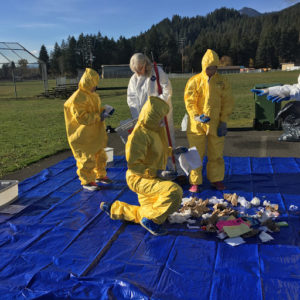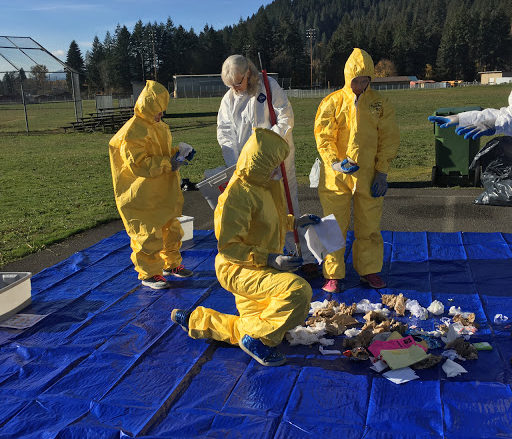This year, I implemented “Fun Fridays” in my classroom, as a way to expand my student’s horizons beyond what fits neatly in the curriculum. Sometimes our Friday afternoons, between lunch and early dismissal, feature arts and crafts, an engineering design project, a flower experiment led by a local gardener, and sometimes, I use that time to highlight a variety of career paths with interesting guest speakers.
So, in September, a local hero of mine came to visit: Lewis County Recycling Program Coordinator, Melanie Case. Melanie started off as an environmental journalist, but eventually found her way into county government. She has a passion for her work and for finding creative and fun solutions to environmental challenges. She taught the class about the most common single-use items that turn up as trash in the ocean, such as straws, plastic utensils, and soda cup lids. She also informed them about where recycling and trash from our community ends up and how it gets there. Then, she helped the class brainstorm alternatives, and even left behind a set of metal reusable water bottles. Many of my students had never owned one before! They were so enthusiastic and curious about Melanie’s work that we decided to invite her back again in November.
November rolled around, and Melanie came up with a great idea. She suggested that we perform a waste audit for our school, to find out where we could decrease our environmental footprint and save money. On the day of the audit, she brought a volunteer and best of all, yellow Tyvek suits that made the students feel like walking bananas! After a safety briefing about germ protection (googles, gloves and the famous yellow suits) and avoiding sharps, the students all went outside. We started by examining classroom waste containers, and sorting them into recyclables, food scraps, untouched food, utensils and milk cartons. Next, we sorted the cafeteria waste and the main office’s trash. Finally, we checked the recycling bin. Through our exploration, we found out that only about ⅓ of what goes in our trash cans actually belongs there. Most of it could be recycled, composted, not thrown away in the first place (in the case of untouched food, which could have gone on a share table, for instance), or not even used (like disposable utensils). Students were fascinated by the results.
Our waste sort was a fantastic real-world example of defining a design problem, and it led naturally into considering alternative solutions and weighing their costs and benefits in terms of time, money and resources. Students came up with creative ideas, including:
- Get rid of styrofoam trays and exclusively use the durable plastic trays we already own.
- Buy a variety of buffet items in bulk for students to choose among, e.g. applesauce and carrots, instead of giving everyone a pre-wrapped serving that they might just throw away.
- Replace our milk cartons with a milk dispenser and cups.
- Re-teach other classes in our school what can and can’t be recycled and make posters to keep in every room as a reminder.
- Talk to the principal and superintendent about getting more recycling containers, which usually fill up, and switching to a smaller trash dumpster.
- Replace our pre-packaged utensil, napkin and straw packets with reusable metal sporks.
Any time I can give my students an authentic scenario, a true problem that needs solving, and let their creativity go to work on it, I leap at the opportunity. This type of learning just does not exist in the pre-written curriculum guides, so I was grateful for my administration’s support and the help of community members to unleash 5th graders’ out-of-the-box thinking about an important topic.
Another sneaky side benefit was that this project got my students excited about several challenging math concepts: finding averages, dividing large numbers, and converting between units. In 5th grade, we study volume, and in this project, they encountered a new unit — cubic yards — and had to convert back and forth from cubic yards to gallons.
Though we have researched many of the potential solutions, our current challenge is setting aside enough time to make a final decision and follow through! Thanks to the motivation of this group, I know we will get there.
In the meantime, we accepted a classroom vermiculture bin from Ms. Melanie. We love taking care of the worms, and one student volunteered to bring back a can full of the food scraps of just our class’s table at lunch to the classroom to compost. Of course, this is not a good long-term solution to the challenge of cafeteria food waste, but so far, it is interesting to see what isn’t getting eaten.
Before Melanie and her volunteer helper left for the day, we all circled up to share gratitude and lessons learned. In addition to heartfelt comments about learning more about what they waste, feeling empowered to easily make a big difference, and enjoying the time getting to know about new adults and their jobs, the students couldn’t help saying, “Thank you SO much for letting us dress up like bananas!”
Contact your local municipal recycling program! Find out what their recycling program entails, what contracts the school already has, and if there are any opportunities to become more green as a school. Ask about outreach options and specifically, if they can help you do a waste audit. Climate change is an ENORMOUS topic, but some of the ways we contribute every day are tiny and mindless. Did you know the average American uses 1-2 straws every day? We discovered that at our school, every child who eats school breakfast and lunch probably throws away 2 straws and 2 utensils right there, plus the plastic they’re wrapped in! A lot of those materials are made abroad, shipped here, and then locked up in a landfill producing methane forever. We can cut down our carbon footprint a lot by being mindful of what we use every day, and better than that, by asking some basic questions of our schools, offices or institutions, to ask if there is a more efficient solution.
Submitted by Amelia Donahey, 5th grade teacher at White Pass Elementary.
